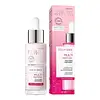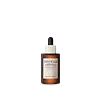What's inside
What's inside
 Key Ingredients
Key Ingredients

 Benefits
Benefits

 Concerns
Concerns

 Ingredients Side-by-side
Ingredients Side-by-side

Water
Skin ConditioningCaprylic/Capric Triglyceride
MaskingGlycerin
HumectantAloe Barbadensis Leaf Juice
Skin ConditioningEthylhexyl Stearate
EmollientIsopropyl Palmitate
EmollientPropanediol
SolventTripelargonin
EmollientBetaine
HumectantSea Water
HumectantPullulan
Simmondsia Chinensis Seed Oil
EmollientGardenia Jasminoides Meristem Cell Culture
AntioxidantHydrolyzed Rhodophyceae Extract
Alpha-Glucan Oligosaccharide
CleansingPolymnia Sonchifolia Root Juice
Skin ConditioningPanax Ginseng Root Extract
EmollientCarnosine
Skin ConditioningCollagen
MoisturisingTocopheryl Acetate
AntioxidantButyrospermum Parkii Butter
Skin ConditioningLeuconostoc/Radish Root Ferment Filtrate
AntimicrobialSerine
MaskingAlanine
MaskingGlycine
BufferingLactobacillus
Skin ConditioningN-Prolyl Palmitoyl Tripeptide-56 Acetate
Skin ConditioningGlutamic Acid
HumectantCeramide Ng
Skin ConditioningCeramide NP
Skin ConditioningCeramide AP
Skin ConditioningCeramide EOP
Skin ConditioningLysine Hcl
Skin ConditioningThreonine
Heptapeptide-7
Skin ConditioningLecithin
EmollientAcetyl Hexapeptide-49
Skin ConditioningPalmitoyl Tripeptide-38
Skin ConditioningArginine
MaskingTetrapeptide-4
Skin ConditioningPalmitoyl Tripeptide-1
Skin ConditioningOligopeptide-68
BleachingAcetyl Heptapeptide-4
HumectantAcetyl Hexapeptide-8
HumectantPalmitoyl Tetrapeptide-7
Skin ConditioningProline
Skin ConditioningPalmitoyl Tripeptide-8
Skin ConditioningPalmitoyl Hexapeptide-12
Skin ConditioningDextran
Phytosphingosine
Skin ConditioningCholesterol
EmollientSodium Lauroyl Lactylate
EmulsifyingLauryl Glucoside
CleansingSodium PCA
HumectantGlycine Soja Oil
EmollientHydrogenated Lecithin
EmulsifyingPentaerythrityl Distearate
EmulsifyingPolyglyceryl-2 Dipolyhydroxystearate
Skin ConditioningPhenoxyethanol
PreservativePentylene Glycol
Skin ConditioningSodium Lactate
BufferingPotassium Cetyl Phosphate
EmulsifyingSodium Carbomer
Emulsion StabilisingHydroxyacetophenone
AntioxidantXanthan Gum
EmulsifyingButylene Glycol
HumectantEthylhexylglycerin
Skin ConditioningDisodium EDTA
Citric Acid
BufferingCarbomer
Emulsion StabilisingHydroxypropyl Cyclodextrin
MaskingMaltodextrin
AbsorbentC12-15 Alkyl Benzoate
AntimicrobialPolysorbate 20
EmulsifyingPCA
HumectantCaprylyl Glycol
EmollientTribehenin
EmollientDipeptide Diaminobutyroyl Benzylamide Diacetate
Skin ConditioningPotassium Sorbate
PreservativeSodium Benzoate
MaskingLactic Acid
BufferingSodium Oleate
CleansingParfum
MaskingCI 17200
Cosmetic ColorantCI 19140
Cosmetic ColorantWater, Caprylic/Capric Triglyceride, Glycerin, Aloe Barbadensis Leaf Juice, Ethylhexyl Stearate, Isopropyl Palmitate, Propanediol, Tripelargonin, Betaine, Sea Water, Pullulan, Simmondsia Chinensis Seed Oil, Gardenia Jasminoides Meristem Cell Culture, Hydrolyzed Rhodophyceae Extract, Alpha-Glucan Oligosaccharide, Polymnia Sonchifolia Root Juice, Panax Ginseng Root Extract, Carnosine, Collagen, Tocopheryl Acetate, Butyrospermum Parkii Butter, Leuconostoc/Radish Root Ferment Filtrate, Serine, Alanine, Glycine, Lactobacillus, N-Prolyl Palmitoyl Tripeptide-56 Acetate, Glutamic Acid, Ceramide Ng, Ceramide NP, Ceramide AP, Ceramide EOP, Lysine Hcl, Threonine, Heptapeptide-7, Lecithin, Acetyl Hexapeptide-49, Palmitoyl Tripeptide-38, Arginine, Tetrapeptide-4, Palmitoyl Tripeptide-1, Oligopeptide-68, Acetyl Heptapeptide-4, Acetyl Hexapeptide-8, Palmitoyl Tetrapeptide-7, Proline, Palmitoyl Tripeptide-8, Palmitoyl Hexapeptide-12, Dextran, Phytosphingosine, Cholesterol, Sodium Lauroyl Lactylate, Lauryl Glucoside, Sodium PCA, Glycine Soja Oil, Hydrogenated Lecithin, Pentaerythrityl Distearate, Polyglyceryl-2 Dipolyhydroxystearate, Phenoxyethanol, Pentylene Glycol, Sodium Lactate, Potassium Cetyl Phosphate, Sodium Carbomer, Hydroxyacetophenone, Xanthan Gum, Butylene Glycol, Ethylhexylglycerin, Disodium EDTA, Citric Acid, Carbomer, Hydroxypropyl Cyclodextrin, Maltodextrin, C12-15 Alkyl Benzoate, Polysorbate 20, PCA, Caprylyl Glycol, Tribehenin, Dipeptide Diaminobutyroyl Benzylamide Diacetate, Potassium Sorbate, Sodium Benzoate, Lactic Acid, Sodium Oleate, Parfum, CI 17200, CI 19140
Centella Asiatica Extract
CleansingButylene Glycol
HumectantGlycerin
HumectantWater
Skin ConditioningPropanediol
SolventCaprylic/Capric Triglyceride
MaskingNiacinamide
SmoothingLactobacillus/Centella Asiatica Extract Ferment Filtrate
Skin Conditioning1,2-Hexanediol
Skin ConditioningDipropylene Glycol
HumectantPolyglyceryl-3 Distearate
EmulsifyingAcrylates/C10-30 Alkyl Acrylate Crosspolymer
Emulsion StabilisingC14-22 Alcohols
Emulsion StabilisingArginine
MaskingHydrogenated Lecithin
EmulsifyingBetaine
HumectantAllantoin
Skin ConditioningPanthenol
Skin ConditioningHydroxystearic Acid
CleansingEthylhexylglycerin
Skin ConditioningHydroxyethyl Acrylate/Sodium Acryloyldimethyl Taurate Copolymer
Emulsion StabilisingGlyceryl Stearate Citrate
EmollientSodium Polyacrylate
AbsorbentAdenosine
Skin ConditioningC12-20 Alkyl Glucoside
EmulsifyingCetearyl Alcohol
EmollientXanthan Gum
EmulsifyingMacadamia Ternifolia Seed Oil
EmollientSodium Phytate
Sodium Hyaluronate
HumectantStearic Acid
CleansingCeramide NP
Skin ConditioningGlyceryl Acrylate/Acrylic Acid Copolymer
HumectantSorbitan Isostearate
EmulsifyingPolyglyceryl-10 Myristate
Skin ConditioningMadecassic Acid
Skin ConditioningAsiaticoside
AntioxidantPhytosphingosine
Skin ConditioningAsiatic Acid
Skin ConditioningSucrose Distearate
EmollientPolyglutamic Acid
Skin ConditioningGlucose
HumectantLauric Acid
CleansingPhytosterols
Skin ConditioningCentella Asiatica Extract, Butylene Glycol, Glycerin, Water, Propanediol, Caprylic/Capric Triglyceride, Niacinamide, Lactobacillus/Centella Asiatica Extract Ferment Filtrate, 1,2-Hexanediol, Dipropylene Glycol, Polyglyceryl-3 Distearate, Acrylates/C10-30 Alkyl Acrylate Crosspolymer, C14-22 Alcohols, Arginine, Hydrogenated Lecithin, Betaine, Allantoin, Panthenol, Hydroxystearic Acid, Ethylhexylglycerin, Hydroxyethyl Acrylate/Sodium Acryloyldimethyl Taurate Copolymer, Glyceryl Stearate Citrate, Sodium Polyacrylate, Adenosine, C12-20 Alkyl Glucoside, Cetearyl Alcohol, Xanthan Gum, Macadamia Ternifolia Seed Oil, Sodium Phytate, Sodium Hyaluronate, Stearic Acid, Ceramide NP, Glyceryl Acrylate/Acrylic Acid Copolymer, Sorbitan Isostearate, Polyglyceryl-10 Myristate, Madecassic Acid, Asiaticoside, Phytosphingosine, Asiatic Acid, Sucrose Distearate, Polyglutamic Acid, Glucose, Lauric Acid, Phytosterols
 Reviews
Reviews

Ingredients Explained
These ingredients are found in both products.
Ingredients higher up in an ingredient list are typically present in a larger amount.
Arginine is an amino acid that is important for human development. Your body uses is it to produce hair keratin and skin collagen.
As a cosmetic ingredient, Arginine has antioxidant properties and can also help repair damaged skin. This ingredient is derived either synthetically or from animals.
Arginine isn't fungal acne safe when used in the presence of other lipids (fats, fatty acids, oils, esters, etc). Oils and fats occur naturally within the skin, so take caution when using Arginine if you're prone to fungal acne.
Learn more about ArginineBetaine is a common humectant (a substance that promotes retention of moisture). It's known to be gentle on the skin and can help balance hydration.
This ingredient is best for improving hydration and soothing irritated skin. Studies also show it helps even out skin tone.
Fun fact: Betaine is naturally created in the skin and body. The kind found within cosmetic products can be either plant-derived or synthetic.
Another name for betaine is trimethylglycine.
Learn more about BetaineButylene Glycol (or BG) is used within cosmetic products for a few different reasons:
Overall, Butylene Glycol is a safe and well-rounded ingredient that works well with other ingredients.
Though this ingredient works well with most skin types, some people with sensitive skin may experience a reaction such as allergic rashes, closed comedones, or itchiness.
Learn more about Butylene GlycolThis ingredient is an emollient, solvent, and texture enhancer. It is considered a skin-softener by helping the skin prevent moisture loss.
It helps thicken a product's formula and makes it easier to spread by dissolving clumping compounds.
Caprylic Triglyceride is made by combining glycerin with coconut oil, forming a clear liquid.
While there is an assumption Caprylic Triglyceride can clog pores due to it being derived from coconut oil, there is no research supporting this.
Learn more about Caprylic/Capric TriglycerideCeramide NP is a type of ceramide and formally known as ceramide 3.
Ceramides are intercellular lipids naturally found in our skin that bonds dead skin cells together to create a barrier. They are known for their ability to hold water and thus are a great ingredient for dry skin.
Ceramides are an important building block for our skin barrier. A stronger barrier helps the skin look more firm and hydrated. By bolstering the skin ceramides act as a barrier against irritating ingredients. This can help with inflammation as well.
If you would like to eat ceramides, sweet potatoes contain a small amount.
Read more about other common types of ceramides here:
Ceramide AP
Ceramide EOP
Ethylhexylglycerin (we can't pronounce this either) is commonly used as a preservative and skin softener. It is derived from glyceryl.
You might see Ethylhexylglycerin often paired with other preservatives such as phenoxyethanol. Ethylhexylglycerin has been found to increase the effectiveness of these other preservatives.
Glycerin is already naturally found in your skin. It helps moisturize and protect your skin.
A study from 2016 found glycerin to be more effective as a humectant than AHAs and hyaluronic acid.
As a humectant, it helps the skin stay hydrated by pulling moisture to your skin. The low molecular weight of glycerin allows it to pull moisture into the deeper layers of your skin.
Hydrated skin improves your skin barrier; Your skin barrier helps protect against irritants and bacteria.
Glycerin has also been found to have antimicrobial and antiviral properties. Due to these properties, glycerin is often used in wound and burn treatments.
In cosmetics, glycerin is usually derived from plants such as soybean or palm. However, it can also be sourced from animals, such as tallow or animal fat.
This ingredient is organic, colorless, odorless, and non-toxic.
Glycerin is the name for this ingredient in American English. British English uses Glycerol/Glycerine.
Learn more about GlycerinHydrogenated Lecithin is created from the hydrogenation of lecithin (a group of phospholipids). Hydrogenation is a chemical reaction between hydrogen and another element.
This ingredient is an emollient and emulsifier. As an emollient, it helps soften skin by trapping moisture within. As an emulsifier, it prevents oil and water ingredients from separating.
Phytosphingosine is a phospholipid naturally found in our skin as a building block for ceramides.. It helps moisturize, soothe, and protect skin.
Phytosphingosine contributes to your skin's natural moisturizing factor (NMF). The NMF is responsible for hydration, a strong barrier, and plasticity. Our NMF decreases with age. Increasing NMF leads to more healthy and hydrated skin.
Studies show products formulated with NMF ingredients help strengthen our skin's barrier. Having a healthy skin barrier reduces irritation and increases hydration. Our skin barrier is responsible for having plump and firm skin. It also helps protect our skin against infection, allergies, and inflammation.
Fun fact: Phytosphingosine is abundant in plants and fungi.
More ingredients that help boost collagen in skin:
Learn more about PhytosphingosinePropanediol is an all-star ingredient. It softens, hydrates, and smooths the skin.
It’s often used to:
Propanediol is not likely to cause sensitivity and considered safe to use. It is derived from corn or petroleum with a clear color and no scent.
Learn more about PropanediolWater. It's the most common cosmetic ingredient of all. You'll usually see it at the top of ingredient lists, meaning that it makes up the largest part of the product.
So why is it so popular? Water most often acts as a solvent - this means that it helps dissolve other ingredients into the formulation.
You'll also recognize water as that liquid we all need to stay alive. If you see this, drink a glass of water. Stay hydrated!
Learn more about WaterXanthan gum is used as a stabilizer and thickener within cosmetic products. It helps give products a sticky, thick feeling - preventing them from being too runny.
On the technical side of things, xanthan gum is a polysaccharide - a combination consisting of multiple sugar molecules bonded together.
Xanthan gum is a pretty common and great ingredient. It is a natural, non-toxic, non-irritating ingredient that is also commonly used in food products.
Learn more about Xanthan Gum